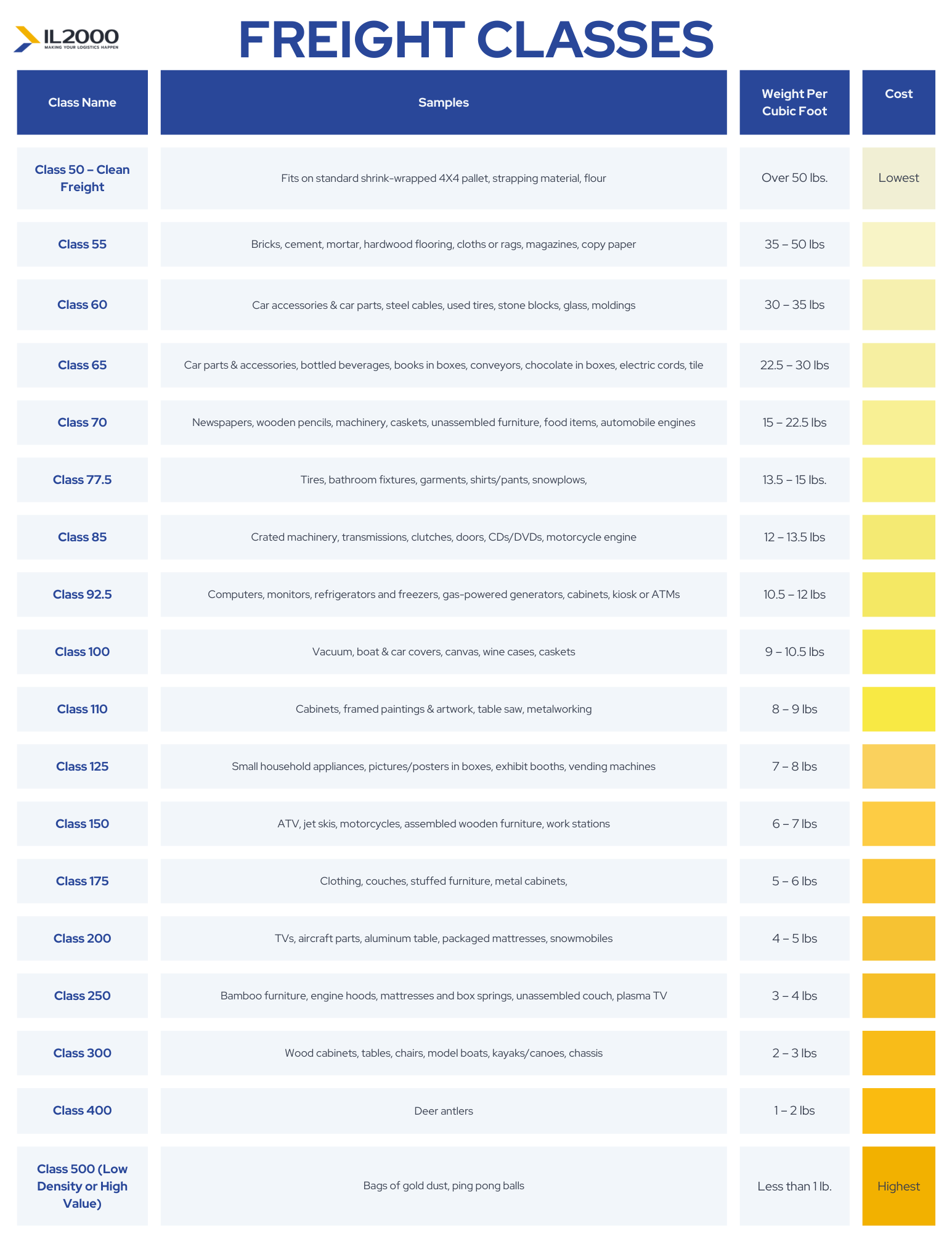What you should know about freight classification and why it’s important.
If LTL shipping is even a small part of your supply chain, you’re probably at least passingly familiar with freight classification. In broad terms, freight classification is a system used by the National Motor Freight Traffic Association (NFMTA) to quantify a commodity’s transportability.
The freight classification system is complex and granular. It has to be. The vast array of commodities moving around the world each day comes in almost endless combinations of size, weight, and densities. Freight classifications equip carriers to accurately assess what they’re moving and charge accordingly.
While you can leave the details of navigating the freight classification system to your friendly IL2000 freight management expert, it's important to have a good grounding in how the freight classification system works.
Consider this blog post a solid 101 introduction to freight classification for LTL.
Defining LTL freight class
First up: Logistics and supply chain management are filled to the brim with terminology. If you haven’t discovered it yet, check out our glossary.
It’s a great resource to quickly get up to speed when a new acronym or term flies your way.
The freight class system includes 18 separate freight classes. These are all given a numerical classification from class 50 to class 500. Check out the list of classes at the end of this blog. The examples in each category will give you a sense of the considerable detail these classifications encompass.
The key variables in allocating a freight class
Determining the freight class of an item of LTL freight comes down to four variables:
 Density: Measured in pounds per cubic foot, density is derived from a commodity’s weight and dimensions. A crate of ping pong balls will have an extremely low density. A bag of gold dust, on the other hand, is extremely dense. The higher a commodity’s density, the lower its freight class and (all other factors aside) the lower its shipping cost.
Density: Measured in pounds per cubic foot, density is derived from a commodity’s weight and dimensions. A crate of ping pong balls will have an extremely low density. A bag of gold dust, on the other hand, is extremely dense. The higher a commodity’s density, the lower its freight class and (all other factors aside) the lower its shipping cost.- Stowability: This variable refers to how readily a shipment can be transported with other freight. Picture an oddly shaped object with lots of space around it during transport; this object has low stowability. Now imagine a regularly shaped object on a pallet that can be placed alongside other similarly shaped objects; this object is highly stowable. The greater its stowability, the lower its freight class.
- Special handling requirements: Commodities that require special handling (often owing to their fragility or how they're packaged) also fall into a higher freight class than objects that are durable and require no special handling. A classic example is bamboo furniture. It's light, but its fragility (coupled with a dash of poor stowability) pushes it into a relatively high freight class.
- Liability: And finally, the financial risk associated with damage, theft or perishability factors into freight class. Adding to the complexity of this one, the threat a shipment poses to adjacent freight is a factor here — not just the liability attached to the shipment itself.
Quick tips to navigate freight class effectively
With the combined complexity of these four factors, it’s easy to get snarled up in the weeds when deciding what freight class a shipment belongs to. Fortunately, we can offer you a handful of tips to make the process easier.
1. Don’t skimp on the info
Every shipping item receives an NMFC code. These codes are derived from a continually updating central database and provide a streamlined way to accurately determine a shipment’s freight classification. When you prepare a Bill of Lading, include both the NMFC code and an accurate freight description.
2. Your TMS is your friend
If you don’t know your shipment’s freight class, use the class suggested by your TMS when you build a quote and input the weight and dimensions. You can access a density calculator directly from the TMS. Don’t have a TMS, or working with a TMS that doesn’t equip you with this kind of data? Let’s fix that! Talk to IL2000 about our best-in-class TMS product.
3. Pay attention to the details and be as accurate as possible
Pay close attention to the carrier’s fine print regarding reclassification and inspections. Some impose significant restrictions and penalties for miscalculation. In a similar vein, avoid lowballing your freight class. Over time you’ll end up paying more in penalties and reclassifications. Managing freight classes well requires a seasoned eye for both detail and accuracy.
 4. Get help when you need it
4. Get help when you need it
Perhaps most importantly of all, when you manage a complex supply chain you don’t need to brave it alone. Working with IL2000 means you have constant access to experts who can help you navigate these complexities - refining your freight classifications, lowering your costs, improving carrier performance, and getting your products to their destinations on time and hassle-free.
Confused about freight class? Talk to IL2000
…because we’re in a class of our own. With our industry-leading TMS, decades of expertise in freight management, and relentless commitment to customer service, we can transform your transportation operation from the ground up.
Save on transport. Improve reliability. And most of all, stay on top of the complexity.
Request a no-obligation consultation today.


